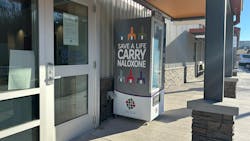Lawrence Transit implements new safety measures at Central Station
Lawrence Transit has put in place new safety measures at the newly opened Central Station.
The safety measures include:
- A naloxone vending machine, dispensing medication designed to rapidly reverse opioid overdose
- An automated external defibrillator (AED), used to revive someone from sudden cardiac arrest
- A storm shelter, available for anyone on the property during inclement weather
- A first aid kit, for minor injuries
The naloxone vending machine is the result of a collaboration between the city of Lawrence, Kan., Lawrence Transit, Douglas County Government, DCCCA and Lawrence-Douglas County Public Health. Naloxone, also known as Narcan, is a medication designed to rapidly reverse opioid overdose. This approach aims to provide immediate first response to opioid overdoses and save lives within the Lawrence community.
The naloxone vending machine is accessible at the Lawrence Transit Central Station, located at Bob Billings and Crestline Drive, on the south side of the building. To access the free naloxone in the machine, customers enter their zip code on the key pad.
“This naloxone vending machine is a significant step forward in combating opioid-related fatalities in our community,” said Bob Tryanski, director of behavioral health projects for Douglas County. “By providing immediate access to naloxone, we empower Douglas County residents to take an active role in saving lives and promoting public health.”
By making it readily available through this vending machine, individuals will have quick access to a life-saving intervention in critical situations.
“DCCCA is an organization dedicated to providing substance abuse treatment and prevention services,” said Chrissy Mayer, DCCCA chief community based services officer. “We recognize the importance of reducing the harm caused by opioid misuse and are proud to partner with this critical endeavor.”
“Lawrence Transit is honored to support programs that enhance public safety and well-being,” said Adam Weigel, transit and parking manager for Lawrence Transit. “We believe that by making naloxone easily accessible through our transit facilities, we can contribute to a safer environment for all passengers.”
